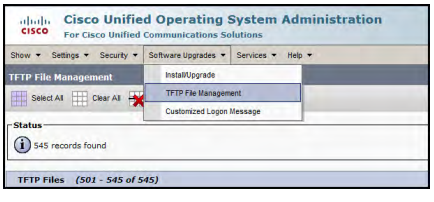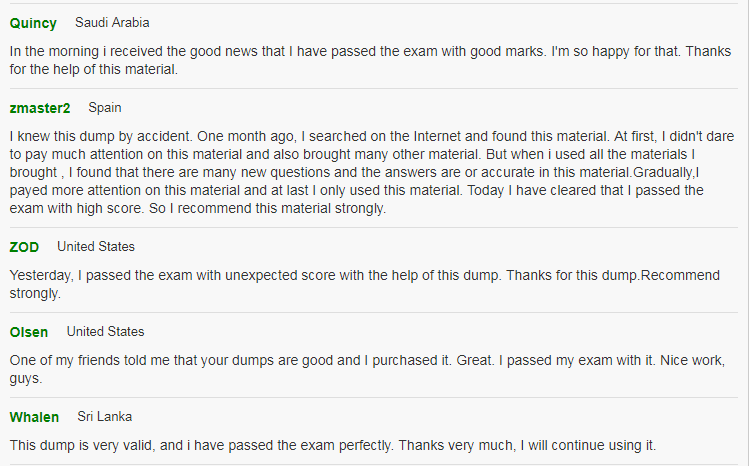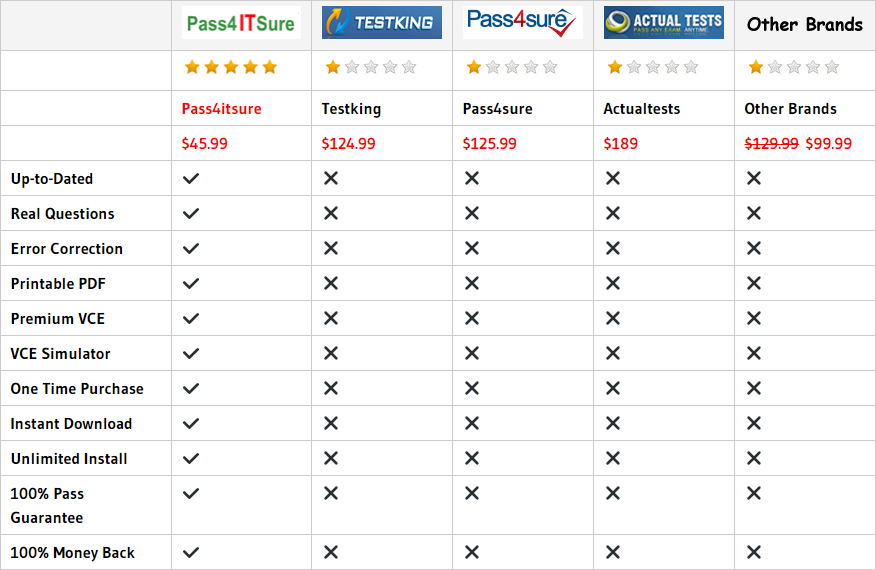[New Dumps] Best Cisco 400-051 Dumps PDF Youtube Study Guides Demo Download Online Q1-Q12
Are you still searching for Cisco 400-051 dumps exam? The Implementing Cisco Collaboration Devices v1.0 (400-051 CCIE Collaboration) exam to plan, design, implement, operate, and troubleshoot enterprise collaboration and communication networks. This 120 minutes exam consists of 90 – 110 questions and covers Implementing Cisco Collaboration Devices v1.0 course. Candidates can prepare for this exam by taking it for the CCIE Collaboration certifications. The pass4itsure 400-051 dumps pdf CCIE Collaboration certifies the switching knowledge and skills of successful candidates.
CCIE Collaboration
Exam Number: 400-051 CCIE Collaboration
Associated Certifications: CCIE Collaboration
Duration: 120 minutes (90 – 110 questions)
Available Languages: English
Do you maintain 100% Guarantee on Pass4itsure.com products?
Yes. Our PDF of pass4itsure 400-051 dumps exam is designed to ensure everything which you need to pass your exam successfully. At Pass4itsure.com, we have a completely customer oriented policy. We invite the rich experience and expert knowledge of professionals from the IT certification industry to guarantee the PDF details precisely and logically. Our customers’ time is a precious concern for us. This requires us to provide you the products that can be utilized most efficiently.
Do you offer free after-sale services?
Yes. We provide 7/24 customer help and information on a wide range of issues. Our service is professional and confidential and your issues will be replied within 12 hous. Feel free to send us any questions and we always try our best to keeping our Customers Satisfied.
Pass4itsure Latest and Most Accurate Cisco 400-051 Dumps Exam Q&As(1-12)
Question No : 1 – (Topic 1)
Which four attributes are needed to determine the time to complete a TFTP file transfer process? (Choose four.)
A. file size
B. file type
C. network interface type
D. round-trip time
E. packet loss percentage
F. response timeout
G. network throughput
400-051 exam Answer: A,D,E,F
Explanation:
Four attributes that are needed to determine the time to complete TFTP file transfer
process is:
File Size
Round-trip time
Packet loss percentage
Response timeout
Question No : 2 – (Topic 1)
Which two statements about using the Load Server option for IP phone firmware distribution are true? (Choose two.)
A. This option must be enabled on at least two servers in a Cisco Unified Communications Manager cluster.
B. This option must be enabled on Cisco Unified Communications Manager service parameters for Cisco TFTP.
C. Phone firmware must be manually copied to any applicable load servers.
D. The load server will not function if its IP address is not in the same subnet as the IP phones.
E. This option is only available for newer IP phone models.
F. This option does not accommodate falling back to Cisco TFTP on error.
Answer: C,F
Explanation:
Choosing the Right Distribution Method
Which of the three different image-distribution methods discussed so far is the best for a customer deployment? Each method has advantages and disadvantages, and they are summarized in Table 1.
Table 1. Summary of Distribution Models
Peer Firmware Sharing
Load Server
Traditional TFTP
Advantages
• Hierarchy is automatic
• One download per phone model on a subnet
• Uses TCP
• Fails back to TFTP
• Speeds up LAN upgrades
• Reduces TFTP CPU load during upgrade
• Has same download time as LAN image distribution
• Distributes TFTP load over multiple TFTP servers
• Proven distribution
• Default behavior
Disadvantages
• Must be enabled on each phone
• Hierarchy is formed for each phone model
• Hierarchy is limited to subnet
• IP must be set on each phone
• Administrator must manually file copy to load server
• No failback to TFTP on error
• More prone to user error
• High-bandwidth requirements
• Multiple requests for same file
• High CPU usage on TFTP server
Question No : 3 – (Topic 1)
Which statement describes a disadvantage of using the Cisco TFTP service to serve IP phone load files?
A. The Cisco TFTP services can run on only one Cisco Unified Communications Manager server in a cluster.
B. Because TFTP operates on top of UDP, there is a high risk of corrupted load file delivery at the completion of the TFTP process due to undetected data loss in the network.
C. If a response is not received in the timeout period, the TFTP server will not resend the data packet.
D. Packet loss can significantly increase the TFTP session completion time.
E. Because TFTP operates with an adaptive timeout period, the time to complete the file transfer is unpredictable.
400-051 dumps Answer: D
Explanation:
Voice traffic cannot recapture lost packets. Rather than retransmitting a lost network connection, the phone resets and attempts to reconnect its network connection.
Question No : 4 – (Topic 1)
Which capability is supported by Cisco Discovery Protocol but not by LLDP-MED?
A. LAN speed and duplex discovery
B. Network policy discovery
C. Location identification discovery
D. Power discovery
E. Trust extension
Answer: E
Explanation:
Cisco Discovery Protocol provides an additional capability not found in LLDP-MED that allows the switch to extend trust to the phone. In this case, the phone is now trusted to mark the packets received on the PC port accordingly. This feature can be used to off-load the switch because now it does not need to police the information being received from the phone.
Question No : 5 – (Topic 1)
Which statement about Cisco EnergyWise domain member neighbor formation is true?
A. Cisco EnergyWise supports static neighbors, but the neighbor relationship is only possible if a noncontiguous domain member and a contiguous domain member have a static neighbor entry pointing to each other.
B. Cisco EnergyWise static neighbors can be formed even if domain members are not physically contiguous.
C. Static neighbors can be manually defined on Cisco EnergyWise domain members, but TCP protocols must be used.
D. Static neighbors can be manually defined on Cisco EnergyWise domain members, but they have a lower priority compared to the autodiscovered members.
E. Static neighbors can be manually defined on Cisco EnergyWise domain members and the TCP or UDP protocol can be used.
400-051 pdf Answer: B
Reference:
Question No : 6 – (Topic 1)
Which statement about the Cisco UC on UCS TRC and the third-party server specs-based virtualization support model is true?
A. Both the UC on UCS TRC and the third-party servers spec-based support models have rule-based approaches.
B. The UC on UCS TRC support model has a rule-based approach and the third-party servers spec-based support model has a configuration-based approach.
C. The UC on UCS TRC support model requires a high level of virtualization experience while the third-party server spec-based support model requires a low to medium level virtualization experience.
D. VMware vCenter is mandatory for the UC on UCS TRC support model but it is optional for the third-party server spec-based support model.
E. VMware vCenter is optional for the UC on UCS TRC support model but it is mandatory for the third-party server spec-based support model.
Answer: E
Explanation:
VMware vCenter is optional when deploying on UC on UCS Tested Reference Configuration hardware mandatory when deploying on UC on UCS Specs-based and Third-party Server Specs-based hardware. vCenter Statistics Level 4 logging is mandatory so that Cisco TAC is able to provide effective support. Click here for how to configure VMware vCenter to capture these logs. If not configured by default, Cisco TAC may request enabling these settings in order to provide effective support. Also note that enablement of specific VMware vSphere management features may require vCenter and/or a higher feature Edition of vSphere ESXi. Cisco Collaboration does not require its own dedicated vCenter. Note that when VMware vCenter is not required and is not used, then VMware vSphere ESXi’s default management interface is its free/included VMware vSphere Client (formerly branded VI Client).
Question No : 7 – (Topic 1)
Refer to the exhibit.

Assuming that the administrator has never performed any manual custom uploads, which two file types can be found when you choose Software Upgrades, followed by TFTP File Management on the Cisco Unified Operating System Administration web page for Cisco Unified Communications Manager? (Choose two.)
A. IP phone configuration files
B. announcement audio files
C. ringer files
D. IP phone license files
E. sample music-on-hold audio files
F. softkey template files
400-051 vce Answer: B,C
Explanation:
The two file types that we get are Announcement Audio Files and Ringer Files.
Question No : 8 – (Topic 1)
Which protocol does the Cisco Prime LAN Management Solution application use to communicate with Cisco EnergyWise domain members?
A. UDP broadcast
B. Cisco Discovery Protocol
C. UDP unicast
D. TCP
E. multicast
Answer: D
Explanation:
Cisco Prime LMS 4.1 uses TCP port 43440.
Question No : 9 – (Topic 1)
Which two statements about the Cisco UC on UCS specs-based virtualization support model are true? (Choose two.)
A. It has a configuration-based approach.
B. It has a rule-based approach.
C. It has less hardware flexibility compared to the third-party server specs-based support model.
D. It has less hardware flexibility compared to the UC on UCS TRC support model.
E. VMware vCenter is optional with this support model.
400-051 exam Answer: B,C
Reference:
Question No : 10 – (Topic 1)
What is the maximum number of call-processing subscribers in a standard deployment of a Cisco Unified Communications Manager Session Management Edition cluster?
A. 3
B. 4
C. 5
D. 8
E. 16
Answer: D
Explanation:
There is no deployment difference between CUCM & CUCM session management Edition cluster. The only difference is that CUCM SME is designed to support a large number of trunk to trunk connections. Thus, 8 subscribers.
Question No : 11 – (Topic 1)
Which two statements about the Peer Firmware Sharing option for IP phone firmware distribution are true? (Choose two.)
A. This option uses a parent-child hierarchy in which a firmware image is downloaded by a parent phone to up to three directly associated child phones.
B. This option must be enabled on Cisco Unified Communications Manager service parameters for Cisco TFTP.
C. This option mandates that the parent phone and child phones be identical, selected phone models.
D. This option allows firmware transfers between phones in different subnets, as long as the round-trip delay is less than 5 milliseconds.
E. This option uses a parent-child hierarchy that must be manually defined by the Cisco Unified Communications Manager administrator.
F. This option allows falling back to the TFTP server in the Cisco Unified Communications Manager cluster.
400-051 dumps Answer: C,F
Explanation:
Peer Firmware Sharing works by setting up a parent-child hierarchy of the phones in which a firmware image is downloaded by the parent phone to a child phone. The advantage of using Peer Firmware Sharing is that instead of all phones individually retrieving a software image, they pass the image along from one phone to another phone on the same subnet. Advantage of PFS:
Hierarchy is automatic One download per phone model on a subnet
Question No : 12 – (Topic 1)
Which two mechanisms does Cisco EnergyWise use for neighbor discovery? (Choose two.)
A. multicast
B. LLDP-MED
C. UDP broadcast
D. Cisco Discovery Protocol
E. TCP
Answer: C,D
Explanation:
Cisco EnergyWise Neighbor Discovery Process
The Cisco EnergyWise neighbor discovery process is the mechanism by which domain members discover each other and populate their Cisco EnergyWise neighbor tables. Cisco EnergyWise queries can subsequently be distributed to all domain members using the neighbor relationships to monitor and control the power usage of devices within a domain. Cisco EnergyWise domain members automatically discover their neighbors through one of two mechanisms:
Cisco EnergyWise UDP broadcast packet
Cisco EnergyWise CDP packets
UDP broadcast packets are automatically sent out switch ports which support Cisco EnergyWise, regardless of whether the interfaces are configured with the no energywise interface-level command. CDP packets are sent when CDP is configured for the switch ports.
Cisco 400-051 Dumps Recommended Training
Cisco Expert-Level Training for Collaboration v1.0:Cisco Expert-Level Training for CCIE Collaboration is a complete blended learning program to accelerate competency and build the skills that are necessary for expert-level certification.
[New Pass4itsure Cisco 400-051 Dumps PDF From Google Drive]: https://drive.google.com/open?id=0BwxjZr-ZDwwWNkViTVpuUWl4SGs
[New Pass4itsure Cisco 400-101 Dumps PDF From Google Drive]: https://drive.google.com/open?id=0BwxjZr-ZDwwWczJDVzl1SUJLWms
The 400-051 (CCIE Collaboration) CCIE Collaboration exam is a 120-minute, 90-110 question assessment that is associated with the CCIE Collaboration certification. This pass4itsure 400-051 dumps exam tests a candidate’s knowledge to plan, design, implement, operate, and troubleshoot enterprise collaboration and communication networks. A candidate is tested on knowledge of CCIE Collaboration course maintenance.

In the recent few years, pass4itsure Cisco 400-051 dumps exam certification have caused great impact to many people. Because pass4itsure exam dumps contain all questions you can encounter in the actual exam, all you need to do is to memorize these questions and answers which can help you 100% pass the exam. This is the royal road to pass 400-051 dumps exam.
Cisco 400-051 dumps pdf training tool has strong pertinence, which can help you save a lot of valuable time and energy to pass IT certification exam. Our exercises and answers and are very close true examination questions. IN a short time of using Pass4itsure 400-051 dumps pdf simulation test, you can 100% pass the exam.

Pass4itsure Provides Best Pass4itsure Cisco 400-051 Dumps Study Guides, Real Cisco 400-051 Dumps Demo Download Online Shop, We Help You Pass CCIE Collaboration.
Pass4itsure Promo Code 15% Off

